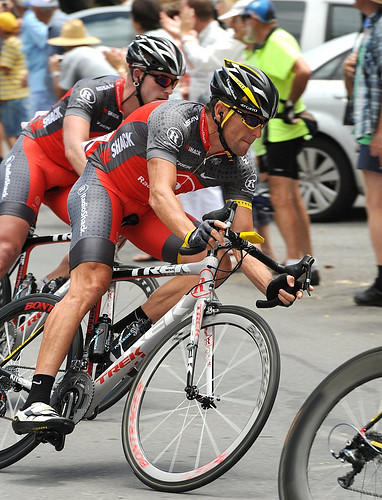
Bob McCarron
Lance Armstrong had a great day in the Pyrenees this past week, in his last attempt at getting a stage win in the Tour de France before he retires (again). He finished sixth, but did his team sponsor, Radio Shack, have a great day? In other words, does any sponsor of a professional bike team get a return on their investment? And why does this matter to you? The biking part may not, but getting a positive return on your marketing dollars should matter.
 The typical selling point of a cycling team’s manager to potential sponsors is that the exposure the brand will receive will be worth the cost of sponsorship. The cycling team will come up with some metrics that attempt to capture the value of sponsorship: media exposure, event attendance, etc. While these metrics are important in terms of building brand awareness, it’s the tracking, measuring and reporting that is the challenging part. In every bike race, without fail, a lone rider will break away from the peloton (the main group of riders) and desperately hang on for the finish line. Ninety-nine times out of 100 this tactic fails miserably. And the rider is ripped apart for the next day’s stage. So why would he do it? So the team can point to the increased exposure that the sponsor received during this valiant effort.
The typical selling point of a cycling team’s manager to potential sponsors is that the exposure the brand will receive will be worth the cost of sponsorship. The cycling team will come up with some metrics that attempt to capture the value of sponsorship: media exposure, event attendance, etc. While these metrics are important in terms of building brand awareness, it’s the tracking, measuring and reporting that is the challenging part. In every bike race, without fail, a lone rider will break away from the peloton (the main group of riders) and desperately hang on for the finish line. Ninety-nine times out of 100 this tactic fails miserably. And the rider is ripped apart for the next day’s stage. So why would he do it? So the team can point to the increased exposure that the sponsor received during this valiant effort.
Really? That’s their marketing strategy?
Who are the sponsors trying to reach? Here are some demographics:
Among adults who have bicycled in the past 12 months, 57 percent are male and 43 percent are female according to Scarborough Research. Fourteen percent are ages 18-24, 21 percent are 25-34, 24 percent are 35-44, 21 percent are 45-54, 13 percent are 55-64, and 7 percent are 65-plus.
Sixty-seven percent have an annual household income of $50,000 or more, with 49 percent at $75,000 or more, and 30 percent at $100,000 or more.
All of this information on potential target audiences is great for some of the financial services firms that are often sponsors of bike teams at the elite level (which costs about $10-$12 million dollars per year). And these sponsorships may build an awareness of a brand, but I’m not so sure they translate into new account growth for those firms. More importantly, I don’t know if these firms know if it translates into new business.
This is where marketing analytics tends to pull away from Lance and the rest of the peloton. Every day the programs that we execute for our customers come with one overriding mandate. We have to be able to track, measure and report on all of our marketing activities so that we can be sure we’re delivering a robust return on our customer’s marketing investment. ROI is the single biggest indicator of a program’s success and a positive ROI helps our customers hit their specific business goals.
Through the use of marketing analytics we help our customers target at a much more granular, and profitable, level than a sponsorship of a team or event. Forget broad demographic categories; we help our customers target based on hundreds of variables and identify those prospects that have the highest lifetime value.
I know there’s a big difference between brand building and direct marketing. But in today’s environment of shrinking budgets and increased scrutiny, it is more critical than ever that marketing professionals demonstrate the effectiveness and profitability of each and every marketing initiative.
As an aging weekend warrior myself, I was pleased that Lance put in such a great performance against the best bike riders in the world. But as a marketing practitioner, I’m not so sure he delivered the best bang for the marketing buck.
Image Courtesy: http://www.theroaddiaries.com/?p=1800
About the Author:
Bob McCarron is the Financial Services and Insurance Practice Leader at SIGMA Marketing Group. Connect with Bob on , or follow him on .
